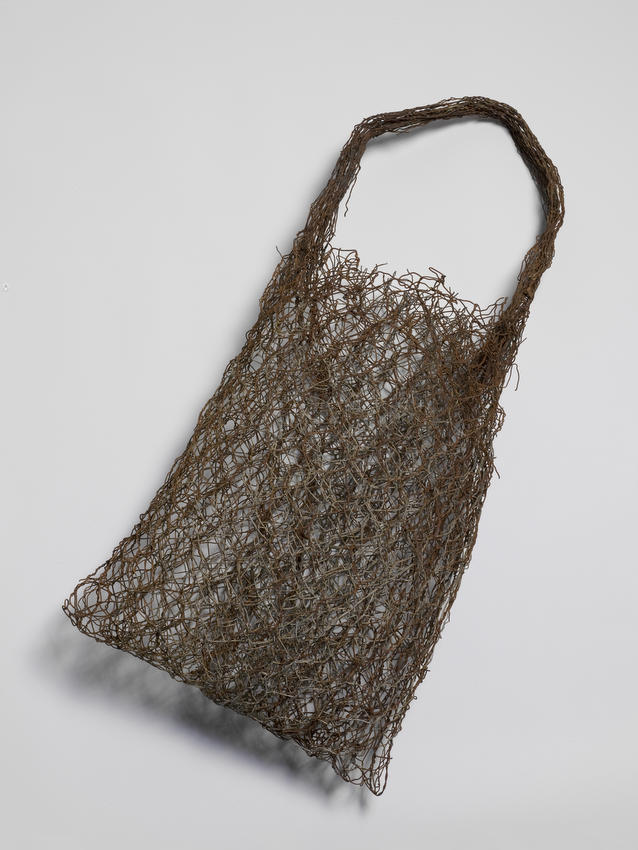We acknowledge the Traditional Owners of the land on which the Queensland Art Gallery | Gallery of Modern Art stands and recognise the creative contribution First Australians make to the art and culture of this country.

Lorraine Connelly-Northey / Waradgerie people* / Australia b.1962 / Narrbong (String bag) 2008 / Rusty rabbit-proof fencing wire and fencing wire / 81 x 28 x 20cm / Purchased 2008. The Queensland Government’s Gallery of Modern Art Acquisitions Fund / Collection: Queensland Art Gallery | Gallery of Modern Art / © Lorraine Connelly-Northey
*Waradgerie (also known as Wiradjuri) is the artist’s preferred spelling
Lorraine Connelly-NortheyNarrbong (String bag) 2008
Not Currently on Display
Lorraine Connelly-Northey uses cast-off materials to produce baskets and bags that radically revision the past. Her use of metal, mesh and wire, in combination with feathers, shells and echidna quills, expresses an Indigenous history coexisting with a settler colonial society.
Connelly-Northey’s Narrbong (String bag) 2008 is fashioned from fly screen and fencing wire, industrial materials imbued with Australian cultural and colonial history. She references Aboriginal weaving techniques and renews carry bag designs through the use of rusty metal retrieved from rubbish dumps.
Her materials and forms interweave the history of the occupation of Aboriginal lands with the fences and fly-screened dwellings that created new divisions in the landscape.
Of Waradgerie and Irish descent, Lorraine Connelly-Northey was born in Swan Hill, in north-west Victoria, where she continues to live and work.
Her approach to basket-making blends skills and attitudes inherited from both parents: the resourcefulness and thriftiness of her Irish father, and the traditional weaving practice inspired by her Aboriginal mother. Connelly-Northey replaces traditional weaving materials with found objects — metal wire and sheets of rusted iron, as well as feathers, stone, wood, bone and shells.
Connelly-Northey recreates the material culture of her ancestors while retaining the beauty of the original material, and in doing so celebrates the resilience and the strength of Aboriginal people.
Discussion Questions
Why do you think Connelly-Northey is using ‘hard’ and often rigid discarded materials, such as metal and wire, to recreate the forms of bags and bowls that were originally soft and pliable?
Classroom Activities
As a class, make a collection of common materials that are discarded every day (for example, plastic bags, plastic cutlery, bottle tops, ring pulls from cans, wrappers, take-away containers). Discuss how each material could be re-purposed and re-imagined by cutting, twisting, hole punching, plaiting, weaving, threading and knotting etc. Working individually or in pairs, construct a small basket, bag or backpack using the collected materials. Include a decorative element in each artwork.